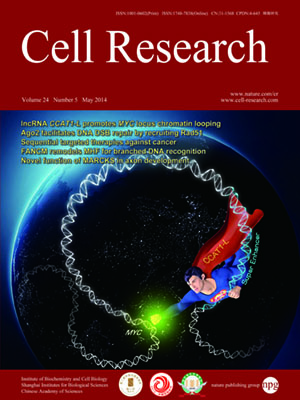
Volume 24, No 5, May 2014
ISSN: 1001-0602
EISSN: 1748-7838 2018
impact factor 17.848*
(Clarivate Analytics, 2019)
Volume 24 Issue 5, May 2014: 632-635 | Open Access
LETTERS TO THE EDITOR
DUF221 proteins are a family of osmosensitive calcium-permeable cation channels conserved across eukaryotes
Congcong Hou1,2,*, Wang Tian1,2,*, Thomas Kleist2,*, Kai He2, Veder Garcia2, Fenglin Bai1, Yanli Hao1, Sheng Luan2 and Legong Li1
1College of Life Science, Capital Normal University, Beijing, 100048 China
2Department of Plant & Microbial Biology, University of California, Berkeley, CA 94720, USA
Correspondence: Sheng Luan, E-mail: sluan@berkeley.edu; Legong Li,(lgli@cnu.edu.cn)
The flow of ions through channels in cell membranes, particularly the entry of calcium ions into the cytosol, serves as a cue for environmental responses in eukaryotes. In animals, calcium-permeable transient receptor potential (TRP) channels act as sensors for temperature, osmotic potential, and other environmental conditions1. Although plants also respond to myriad environmental perturbations with cytosolic calcium fluxes2, stress-gated calcium-permeable channels like TRPs in animals are not found in land plants. Several families of proteins, including glutamate receptor-like (GLR) proteins, cyclic nucleotide-gated channels (CNGCs), and annexins, have been linked to calcium fluxes in plant cells3. However, none of them has been shown to respond directly to stress signals. Because cytosolic calcium elevation is one of the earliest responses of plant cells to stress treatments1,4, and calcium-binding proteins are required for several environmental stress responses5, stress-activated calcium channels are candidates that may link stress stimuli to calcium-dependent downstream responses. We thus seek to isolate plant genes that encode possible calcium channels that are gated by stress signals, such as osmotic stress.
10.1038/cr.2014.14
FULL TEXT | PDF
Browse 2267


